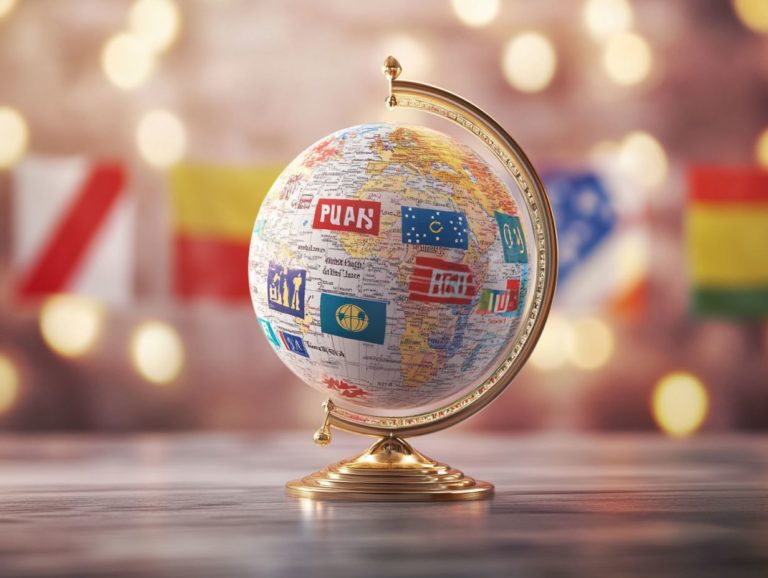Understanding the Madrid Protocol for Trademarks
In today s global marketplace, protecting your brand is more critical than ever.
Let’s dive into the Madrid Protocol and see how it can work for you! It presents a streamlined approach to registering trademarks internationally, making the process simpler for businesses.
This article will break down the Madrid Protocol, explore its numerous benefits like cost savings and enhanced efficiency guide you through the application steps, and highlight potential limitations.
You’ll also find discussions on alternatives for international trademark protection. Discover how you can effectively safeguard your brand on a global scale.
Contents
- Key Takeaways:
- Overview of the Madrid Protocol
- Benefits of Using the Madrid Protocol
- How to File a Trademark Application under the Madrid Protocol
- Limitations and Risks of the Madrid Protocol
- Alternatives to the Madrid Protocol
- Frequently Asked Questions
- What is the Madrid Protocol for Trademarks?
- How does the Madrid Protocol work?
- Which countries are part of the Madrid Protocol?
- What are the benefits of using the Madrid Protocol?
- Are there any limitations or restrictions when using the Madrid Protocol?
- What happens after the international trademark is registered?
Key Takeaways:

- The Madrid Protocol allows trademark registration in multiple countries through one application.
- Save time and money with this efficient process.
- Consider limitations and potential risks before filing.
Overview of the Madrid Protocol
The Madrid Protocol is an important system for navigating international trademark application processes. It streamlines trademark registration across various jurisdictions while adhering to national laws and the requirements set by the World Intellectual Property Organization (WIPO).
This system enables trademark owners to secure their rights in multiple member countries with just one application submitted to their designated Office of Origin.
Grasping the intricacies of the Madrid Protocol is essential for effective trademark management and enforcement as you protect your intellectual property in a changing global marketplace.
What is the Madrid Protocol?
The Madrid Protocol is an international treaty managed by the World Intellectual Property Organization (WIPO). It enables trademark owners to register and manage their trademarks worldwide through a single application process.
This approach significantly simplifies the complexities of international trademark registration, minimizing the need for multiple applications across various jurisdictions. Established in 1989 and continuously evolving, the Protocol offers a robust framework for protecting your brand in member countries.
This not only saves you time and resources but also helps you efficiently monitor and enforce your rights globally.
The advantages of this treaty are particularly beneficial for businesses aiming to expand their market presence internationally. It allows you to navigate trademark law with greater ease and confidence.
Benefits of Using the Madrid Protocol
Utilizing the Madrid Protocol presents many advantages for businesses looking to safeguard trademarks globally.
You ll enjoy a streamlined trademark registration process that saves you time and effort. This approach also saves you money.
Simplifying international trademark management means you can focus more on growing your brand rather than getting lost in the complexities of trademark law.
Take the next step by researching more about the Madrid Protocol or consulting with an expert!
Streamlined Trademark Registration Process

The Madrid Protocol, a treaty that makes it easier to register trademarks internationally, makes trademark registration a breeze! This innovative system allows a single international application based on your existing national trademark, significantly reducing both the administrative burden and the associated fees.
This system is designed to facilitate global trademark protection. You can leverage your established national trademarks as a springboard for broader international rights.
The role of the IP Office is vital in this process. It manages filings and ensures compliance with diverse jurisdictions. By utilizing your existing rights, you can navigate the complexities of trademark filing more efficiently, minimizing the need for multiple applications and avoiding unnecessary costs.
Not only does this accelerate your registration timeline, but it also simplifies the management of trademarks across various countries. This enhances administrative efficiency in protecting your intellectual property on a global scale.
Cost Savings for International Protection
One of the most compelling advantages of the Madrid Protocol is the potential for significant cost savings on application fees and renewal expenses compared to filing separate trademark applications in each jurisdiction. This streamlined approach enables you to manage your trademark registrations more effectively, reducing the financial strain typically associated with traditional methods.
For instance, filing a single application under the Madrid System can cost you just a few hundred dollars, while traditional registration in multiple countries can easily run into the thousands per jurisdiction. Renewal fees under the Madrid Protocol can be paid together, making budget management a lot easier.
You can see how these savings can cumulatively yield a favorable return on investment. This makes it easier for you to establish and maintain a global presence.
How to File a Trademark Application under the Madrid Protocol
Filing a trademark application under the Madrid Protocol is a crucial step to protect your brand. Start this process today to secure your rights internationally! It requires you to navigate several key steps:
- Start by meticulously preparing your application to ensure it aligns with compliance requirements.
- Next, you’ll need to designate the member countries where you seek protection.
- Depending on the jurisdictions involved, it may also be beneficial to collaborate with a local agent who can assist with specific filing formalities.
Each of these elements is crucial for a successful application process.
Steps and Requirements
Filing a trademark application under the Madrid Protocol requires a deep understanding of both the application process and the compliance requirements outlined by WIPO. Navigating this complex system can feel overwhelming. However, by breaking it down into manageable tasks, you can enhance your clarity.
- First, gather all necessary documents, such as proof of trademark use and identification forms.
- Next, conduct a thorough study of the specific countries where you seek trademark protection, as each jurisdiction may have its own criteria.
Understanding the compliance requirements will help you avoid potential pitfalls along the way. It’s wise to consult with a trademark attorney who is well-versed in the intricacies of the Madrid Protocol. They can provide valuable tips and insights to strengthen your application, significantly improving your chances of successful registration.
Limitations and Risks of the Madrid Protocol

While the Madrid Protocol presents a wealth of advantages, it’s essential to recognize that it also carries specific limitations and risks. You may encounter potential trademark disputes and face the possibility of provisional refusals or substantive examinations from the IP Offices in member countries.
Possible Challenges and Restrictions
Possible challenges and restrictions under the Madrid Protocol can emerge during your trademark application process. Issues can arise from following local laws and arguments over trademark ownership in designated jurisdictions.
Navigating these obstacles often requires a thorough understanding of each country’s trademark regulations, which can differ significantly.
For example, a trademark that sails through registration in one nation might encounter hurdles in another due to existing similar marks. Varying interpretations of descriptiveness can also lead to complications.
Localized legal practices can introduce additional complexities. Inconsistent enforcement standards and fluctuating timelines for approval can create further challenges.
If you re seeking international trademark protection, you must be aware of these intricacies. Ensure your applications are compliant and strategically positioned to reduce the risk of litigation or rejection in diverse markets.
Alternatives to the Madrid Protocol
While the Madrid Protocol is a powerful tool for protecting your trademark, alternative options are available.
Businesses like yours can explore national trademark registrations or bilateral agreements to effectively secure trademark rights in foreign jurisdictions.
Other Methods of International Trademark Protection
Other methods for securing international trademark protection include filing separate national applications in individual countries. You can also leverage bilateral agreements between states to establish trademark rights.
While these approaches can be effective, they often introduce significant complexity and varying costs. Each nation comes with its own set of legal requirements, fees, and processing times.
For instance, direct national filings may allow for a more tailored protection strategy but will demand a greater investment of your time and resources. Bilateral agreements can streamline the process, yet they may not cover all aspects of trademark rights or offer a consistent level of protection.
In contrast, the Madrid Protocol presents a streamlined option, allowing you to secure trademarks across multiple jurisdictions with a single application. This can significantly reduce administrative burdens and overall expenses, while providing comprehensive coverage that aligns with international standards.
Frequently Asked Questions

What is the Madrid Protocol for Trademarks?
The Madrid Protocol is an international treaty that allows trademark holders to register their marks in multiple countries through a single application.
How does the Madrid Protocol work?
Under the Madrid Protocol, a trademark holder can file an application with their national trademark office. This application will then be forwarded to the International Bureau of the World Intellectual Property Organization (WIPO).
The International Bureau examines the application, and if it meets the requirements, it is published for review by designated countries for registration.
Which countries are part of the Madrid Protocol?
As of 2021, there are 108 countries that are part of the Madrid Protocol, including the United States, China, Japan, and countries in the European Union. A full list of member countries can be found on the WIPO website.
What are the benefits of using the Madrid Protocol?
The Madrid Protocol offers several benefits for trademark holders. These include cost savings, a simplified application process, and easier management of an international trademark portfolio!
It also allows for a single renewal and the ability to expand into additional territories in the future.
Are there any limitations or restrictions when using the Madrid Protocol?
Yes, there are certain limitations and restrictions when using the Madrid Protocol. The trademark must be registered or pending in the applicant’s home country.
If the original application is rejected, the international application will also be rejected. Any changes or updates to the original application must be made through the national trademark office.
What happens after the international trademark is registered?
After the international trademark is registered, it will be subject to the laws and regulations of each designated country or region. The trademark holder must monitor and maintain their trademark in each country.
It’s important that the trademark holder stays on top of renewals, which means updating the trademark to keep it active. Don’t forget to be aware of potential challenges from other companies!
Stay proactive! Keeping your trademark active is essential for protecting your brand.





